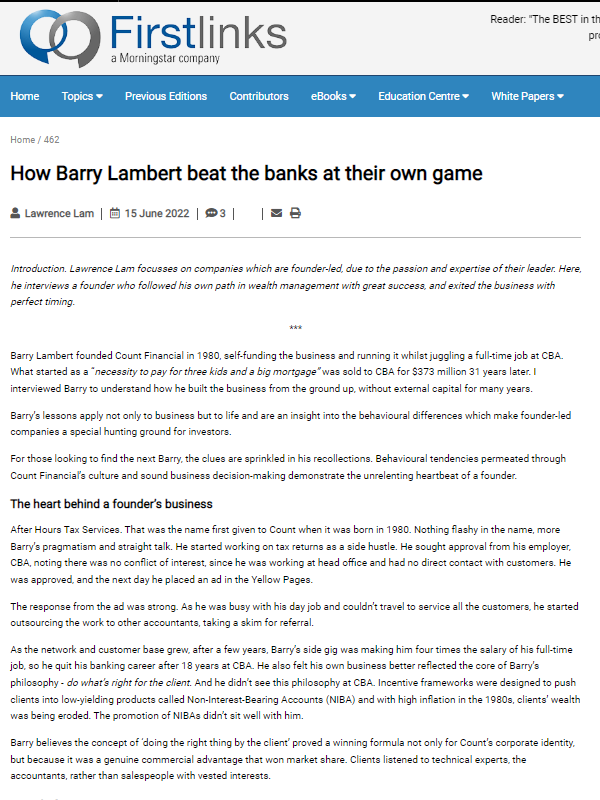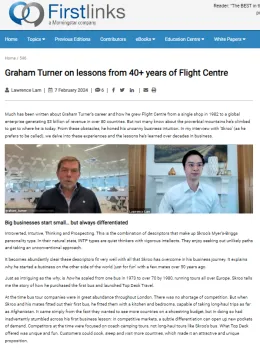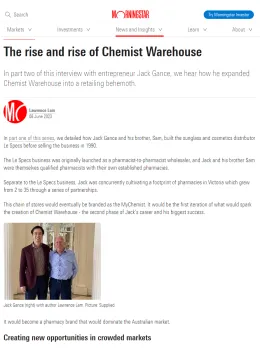First published on Firstlinks, 15 June 2022
Barry Lambert founded Count Financial in 1980, bootstrapping the business and running it whilst still juggling a full-time job at CBA. The business that started out as a “necessity to pay for three kids and a big mortgage” was eventually sold to CBA for $373 million 31 years later.
I interviewed Count Financial’s founder Barry Lambert to understand how he built the business from the ground up, bootstrapping it for many years. Investors that rode the journey with this founder were handsomely rewarded. But how did Barry do it?
In this publication I distil some of Barry’s lessons which apply not only to business, but to life. And with each interview session I delved deeper into his mindset, drawing out the behavioural differences which make founder-led companies such a special hunting ground for investors.
For those looking to find the next Barry, the clues are sprinkled in his recollections; behavioural tendencies which permeated through Count Financial’s culture and ultimately translated into business success. I see this time and time again with the founder-led companies I analyse. Sound business decision-making leads to long-term profits – the source of it all is the unrelenting heartbeat of a founder.
The heart behind a founder’s business
After Hours Tax Services. That was the name first given to Count when it was born in 1980. If ever there was a business name that aptly reflected the inner personality of it’s founder, After Hours Tax Services would be it. Barry oozes an aura of pragmatism and straight talk.
In a deep raspy voice Barry tells me he needed side income and that’s why he started working on tax returns as a side hustle. He explains how he sought approval from his then employer CBA, noting to them there was no conflict of interest, since he was working at head office and had no direct contact with customers, therefore posed no risk to the bank. He was approved, and the next day he placed an ad in the Yellow Pages.
The response from the ad was strong. Because he was busy with his day job and couldn’t travel to service all the customers, he started outsourcing the work to other accountants, taking a skim for each client he referred. That was how Count’s accounting network started in the early days.
As the network and customer base grew, so too did Barry’s income. Barry chuckles as he recalls how after a few years the side gig was making him four times the salary of his full-time job at CBA. He had achieved his original goal – the business was making ample income for him to support his family whilst concurrently developing a career in banking.
So why not keep the side business going while he built his career in banking? What motivated Barry enough to ultimately quit CBA and pursue business full-time?
The answer came down to the very core of Barry’s philosophy in business – do what’s right for the client. And he didn’t see this philosophy at all when he was at CBA. In fact he witnessed the opposite. Back then incentive frameworks were designed to push clients into low-yielding products called Non-Interest Bearing Accounts (NIBA) and with inflation at all time highs in the 1980’s, clients’ wealth were being eroded away in these NIBAs. Yet the banks continued to promote NIBAs. This didn’t sit well with Barry. As he says to me “I’m not particularly religious, but I have a strong sense of right and wrong”.
He voiced his disagreement to higher ups to no avail, and so he eventually left CBA after 18 years to pursue his business full-time, knowing that he was in control of doing the right thing by his clients. This was the fundamental crux of what Count Financial was about, and would motivate Barry for the next three decades. The concept of doing the right thing by the client proved to be a winning formula not only for Count’s corporate persona, but also because it was a genuine commercial advantage that won market share. Clients listened to technical experts (accountants), rather than salespeople with vested interests.
Speed of improvement
Barry’s matter-of-fact approach to business rubbed off on the way Count was run – if improvements made sense, they would be done quickly without bureaucratic red tape. Take for instance licencing. Count was an early adopter of Australian Financial Services (AFS) Licensing for its financial advisors, the philosophy being to remain ahead of regulations, rather than on the back foot. Back then this wasn’t the norm, many companies took a wait-and-see approach when it came to regulatory compliance. There were some of Count’s competitors that were outright complacent – Barry recalls how he raised the need for licencing at a lunch with a Big 4 bank and was told “licencing is for people like you; we don’t need to be licenced”.
Improvement is a necessity of business. Change is inevitable and that was how Barry saw it. As it turns out, he was right.
The speed at which improvements could be made at Count was enabled by its relatively flat hierarchy. Barry remained the brains of the business and all major decisions went through him. There were no convoluted committees and steering groups to contend with. If the strategy made sense, it could be executed much faster than the competition. Case in point – Count converted into a paperless operation over a few weeks, again an early adopter of emails. They lost seven accounting firms in the transition, but as Barry says, it was necessary to keep improving the efficiency of the business. Making a change this bold in any other organisation would have taken years to decide and even more years to implement. For a founder, speed is an advantage.
I can still picture Barry chuckling as he says to me “I don’t mind the banks being a competitor because I know I’ll be 5 years ahead of them”. How true.
Problem solving
Barry points out the subtle difference between speed of execution versus speed of decision-making. Executing quickly doesn’t mean decisions are rushed and ill-considered. Quite the contrary as Barry explains to me. He often took his time with decisions “it [the solution] often doesn’t come to you straight away, you usually have to sit on it a bit”.
There are two main criteria Barry uses to make big decisions:
- solve the problem from first principles rather than copying others; benchmarking is a flawed concept
- the answer should be simple to manage and not too stressful to implement
It was with this framework that Count morphed itself from an accounting network into a wealth management network. In the 1980’s there were no other hybrid accountant/financial planner firms. As with all great ideas, it always seems so obvious in hindsight; there was no one better placed to provide finance advice than accountants who knew the financial position of their clients intimately.
The solution came about not because Barry copied a competitor, but because he started receiving a lot of calls from wealth advisors who wanted referrals from Count’s network. The problem was these were all salespeople who were motivated by selling investment products, not providing the right advice for clients. Barry disagreed with that. “Clients deserve to receive financial advice from professionals and not salespeople” was how he put it to me. Count applied for its financial advisory licence and started the new service the following year.
Count had carved out a unique position in a competitive field. By not copying others, Barry created a first mover advantage because Count was truly independent and relied on accountants providing tailored financial advice, a clear differentiator from his competitors who appointed salespeople to promote the selling of financial products as though they were selling a pair of shoes.
The unique strategies Barry used to scale Count Financial will be covered in Part 2 of my interview along with how he extended the gap between Count and its competitors, and his thoughts on effective management.




